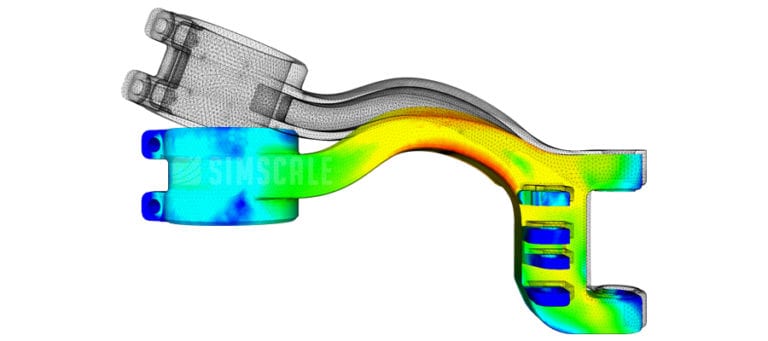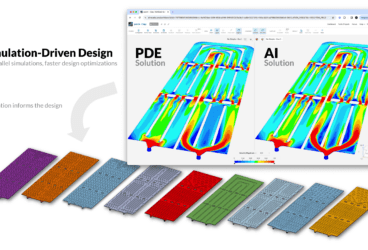Computer-aided engineering (CAE) is one of the most powerful tools of the recent era, utilized in almost every field to provide efficient, cost-effective results. Conducting physical experiments for each design version is both time and cost intensive. Instead, design engineers can perform numerical studies to reduce the number of prototypes, saving a significant amount of effort, money, and time. However, no matter how well the simulation software performs, it is unlikely that the numerical analysis will provide 100% accuracy.
For a reliable numerical analysis, verification and validation assessments (V&V) are the proposed models that are implemented in various fields such as engineering, medicine, informatics, and economics. Even though verification and validation are generally used interchangeably, they are actually distinct concepts, investigating the accuracy and credibility of numerical studies from different perspectives.
Discover all the simulation features provided by the SimScale cloud-based CAE platform. Download the document below.
Verification
- Investigates if the computational model accurately represents the underlying mathematical model and also if the resulting code can be properly used for an analysis [1]
- Asks the question: “Are we building the system correctly?” [2]
- Focuses on solving the equations in a suitable way [3]
- Examines numerical uncertainty
Validation
- Determines if the computational simulation agrees with the physical reality [1]
- Asks the question: “Are we building the right system?” [2]
- Focuses on solving the correct equations (i.e., getting the physics right) [3]
- Examines the difference between the numerical simulation and the experimental results
Standards for Verification and Validation
With the increasing use of computer-aided engineering software in the last 50 years, a standard regarding verification and validation has become a necessity. The first V&V guideline was issued by the American Nuclear Society in 1987. Further development of V&V guidelines was conducted by other professional organizations to provide industry-specific standards. In 1998, the American Institute of Aeronautics and Astronautics (AIAA) released its first modern standards document. Thereafter, the American Society of Mechanics Engineers (ASME) V&V Standards Committee issued documents related to fluid dynamics and solid mechanics, including:
- A Standard for Verification and Validation in Computational Fluid Dynamics and Heat Transfer, ASME V&V-20 (2009).
- An Illustration of the Concepts of Verification and Validation in Computational Solid Mechanics, ASME V&V-10.1 (2012).
Mathematical commands for an easily-expressed example of verification and validation can be used. Imagine a study of the product of 3 and 1. To obtain the result of 3, either multiplication or division can be applied. When a division is applied to solve the problem, it gives an accurate result for the product of 3 and 1, but when the same logic is applied to the product of 4 and 2 to check for consistency, the division command severely fails (Figure 1).

Aside from basic mathematical commands, both CFD and FEA encompass nonlinear equations and complicated simulation steps to describe physical systems. Hence, V&V assessments should be carried out separately and incrementally to ensure reliable processes. In order to avoid false conclusions regarding the validity of the model, it is necessary to perform a verification assessment before a validation assessment. If the verification assessment has ambiguities which result in errors, the validity of the model fails simultaneously [5]. If the verification process succeeds, the validation process must be confirmed with experimental studies as it is required that the comparison studies rely upon real-time data.
Verification is the process that investigates the solution of the equations with regards to the verification of code (programming) and the verification of the calculation (mathematical models and numerical methods). The fundamental duties of the process consist of finding programming errors and examining mathematical calculations in order to solve the equations correctly. The steps of verification assessment [4] include:
- Error detection in the underlying computer programming code
- Iterative convergence
- Grid convergence
- Temporal convergence analysis for transient cases
- Comparison of results with a reliable solution
The validation assessment examines the relationship between the equations and the physical experiments in order to solve the correct equations. An experimental setup such as a benchmark is used to conduct studies to investigate the physics. During experimental studies, some level of error occurs and thus it is essential to ensure that the experimental results are reproducible. The main steps of the validation process [4] can be summarised as follows:
- Comparison between the CFD or FEA results and the experimental data
- Investigation of numerical model uncertainties (for example, the turbulence model)
The complete process of analysis based on V&V assessments is shown in Figure 2:

We can conclude that it is obvious that V&V assessments should be implemented in all studies encompassing numerical analysis. However, due to varying error rates throughout both the verification and validation processes, 100% accuracy is almost impossible. Hence, for V&V assessments, it is essential to specify the level of acceptable error regarding the model and solution.
If you are interested in learning more about verification and validation, check out this list of public validations performed with SimScale.

References
- Overview of CFD Verification and Validation, NASA, 2008
- Barry Boehm, Software Engineering Economics, 1981
- Patrick J. Roache, Verification and Validation in Computational Science and Engineering, 1998
- A Standard for Verification and Validation in Computational Fluid Dynamics and Heat Transfer, ASME, V and V-20, 2009
- Guide for Verification and Validation in Computational Solid Mechanics, ASME, V and V10, 2006



